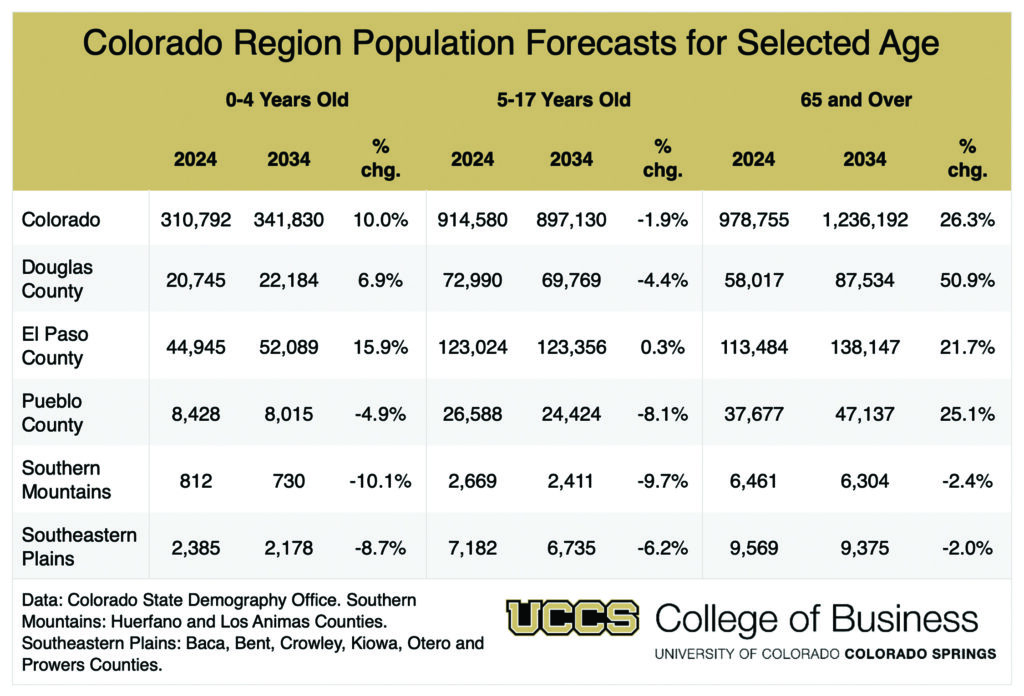by William Craighead PhD, UCCs
Coloradans’ mixed feelings about growth are well-known, so not everyone will be happy about the latest forecasts for the state’s population.
Over the two decades to 2023, the state added 1.3 million residents. In percentage terms, Colorado’s growth rate was roughly twice that of the U.S. overall, and the 7th-highest among states.
Recent forecasts project Colorado continuing to grow faster than the U.S. overall. Over the decade 2024-34, the Colorado State Demography Office forecasts an increase of nearly 687,000 in the state’s population (an 11.7% increase), while the Congressional Budget Office projects 6.1% growth nationally.
Colorado has been growing fast and is expected to continue to add population. However, the growth has been quite uneven across regions, including within Southern Colorado. From 2003 to 2023, Douglas County’s population exploded, increasing by 74%, El Paso County’s population rose by 35%, and Pueblo County’s by 15%. Even as these urban and suburban areas expanded, the Southern Mountain region – Huerfano and Los Animas counties – saw an 11% population decline and the Southeastern Plains – Baca, Bent, Crowley, Kiowa, Otero and Prowers counties – had their population fall by 10%.
These disparities are forecast to continue over the next decade. Douglas County’s growth is forecast to come down, but still be substantial, at 12%; El Paso County’s population is projected to increase by 14%; and Pueblo County’s by 6%. Meanwhile, the populations of the Southeastern Plains and Southern Mountain regions will decrease by 4% and 7%, respectively, according to the State Demography Office forecast.
It’s not just the number of people that continues to evolve – the age composition is changing as well. The U.S. population continues to grow older, with the youngest of the baby boom generation (born 1946-64) crossing the traditional retirement age of 65 during the next five years. While Colorado’s population is younger than that of the U.S. overall – our median age in 2023 was 37.9, versus 39.2 for the U.S. – we are part of this trend. The share of Coloradans who are 65 and older is forecast to increase from 16.7% in 2024 to 18.9% in 2034. Douglas County is projected to have a very large increase in its over-65 population as people who moved there to raise families in the past two decades get older. The number of those over 65 in the Southern Mountain and Southeastern Plains regions will decrease, but not as much as their populations overall, so the share that is over 65 will be rising in those areas as well. This will impact the types of housing and services needed. Businesses will want to consider how they can adapt to the opportunities created by an older set of consumers.
These population trends will affect Colorado’s education system as well. The number of school-age children is projected to decrease over the next ten years. While this can reduce education costs somewhat, it also can bring difficult choices about operating schools with declining enrollments.
The state’s population includes a large millennial (born between 1981 and 1996) cohort. This is the echo of the baby boom, and its own echo is coming with a forecast increase in the number of young children in the state. This is especially notable in El Paso County, which will face increasing needs for childcare with a projected increase of 15.9% in its 0-4-year-old population over the next decade. While Colorado’s school-age population is forecast to be smaller ten years from now, this new cohort, which some are calling “generation alpha,” will result in a larger group of kids in Colorado schools twenty years hence.














